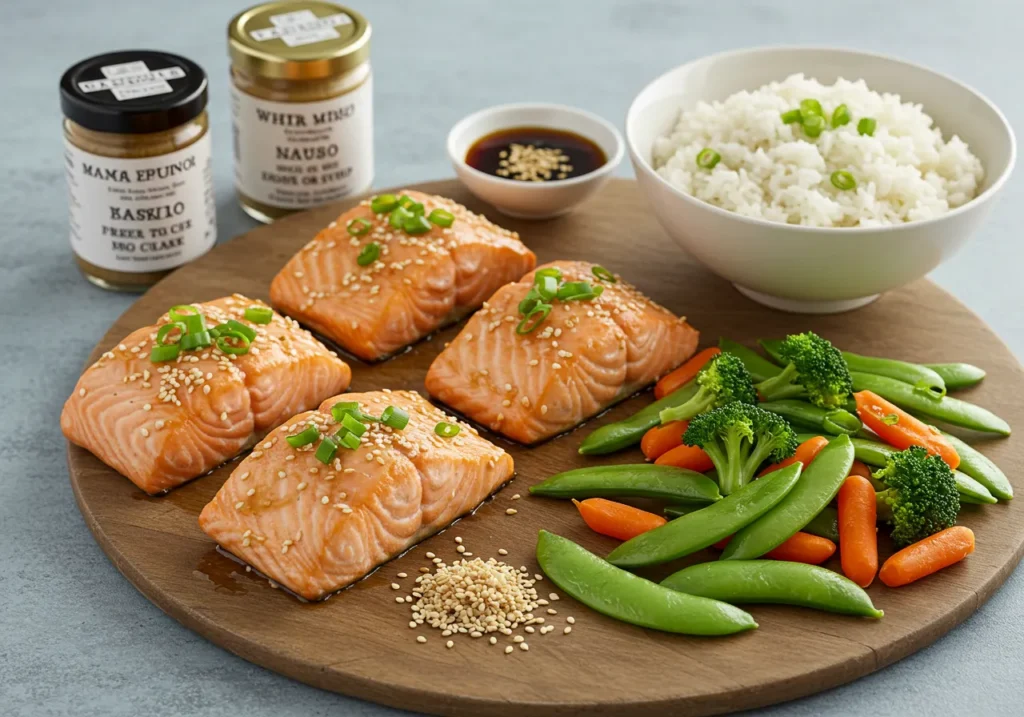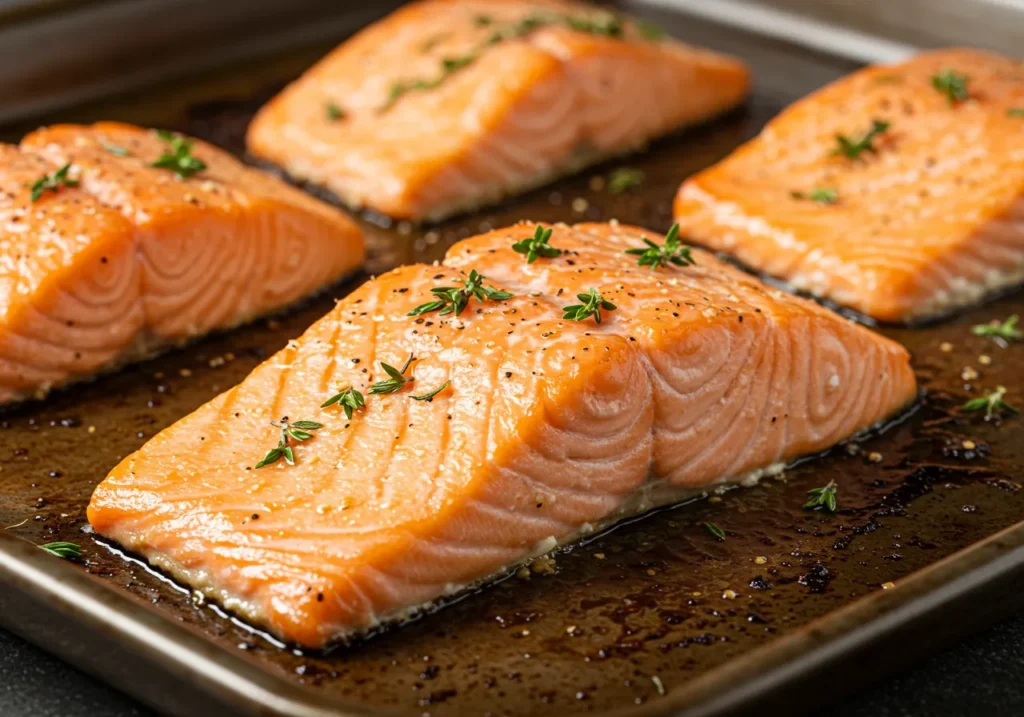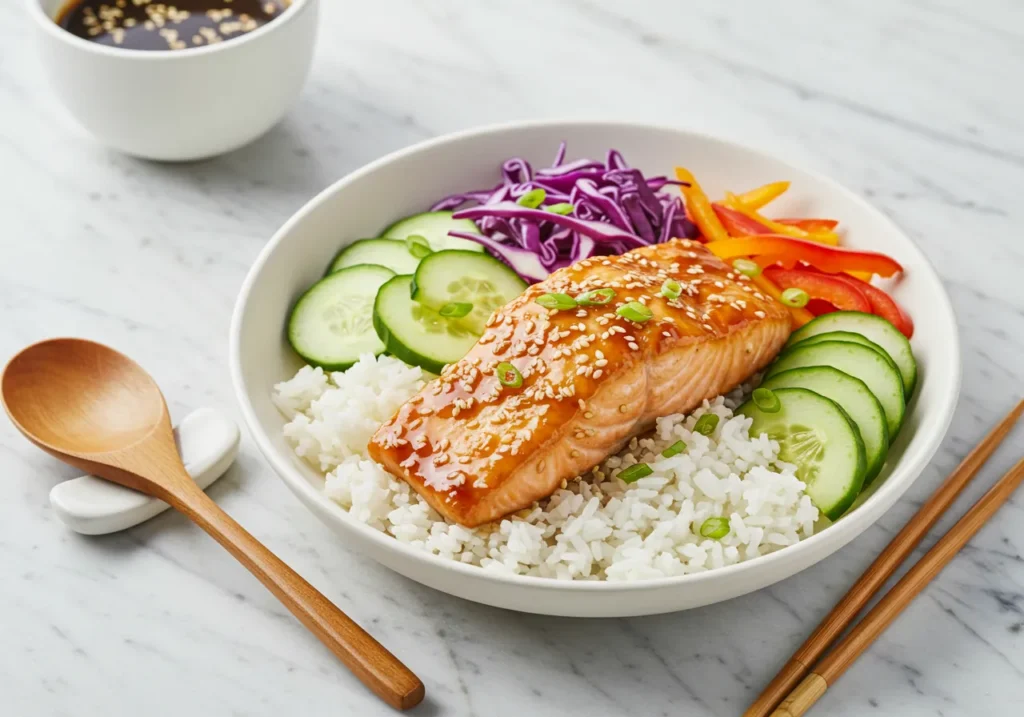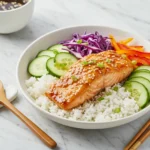Introduction
Elevate your culinary game with the Sticky Miso Salmon Bowl Recipe—a dish that promises to delight your taste buds while offering a healthy and vibrant meal option. This delightful bowl brings together rich flavors, nutritional value, and a beautiful presentation. Consequently, why is the sticky miso salmon bowl so good? Let’s explore this glorious dish that will undoubtedly become a staple in your kitchen!
🍴 Why Sticky Miso Salmon Bowl Is So Good?
Balanced Nutrition 🌱
The sticky miso salmon bowl is a nutritious meal, highlighted by salmon’s omega-3 fatty acids that promote heart and brain health. Accompanied by vibrant vegetables and wholesome grains, it offers fiber, vitamins, and minerals essential for digestive health. This combination supports overall wellness and helps maintain a healthy gut.
Umami Explosion 🌊
This dish excels in flavor thanks to miso paste, which adds a deep, savory umami taste. The fermentation process not only enhances flavor complexity but also provides probiotics that support gut health. The sweet, savory, and nutty notes of the miso glaze create an irresistible flavor experience.
Versatility 🥗
The sticky miso salmon bowl is highly adaptable, allowing substitutions like tofu for a vegan option or chicken for meat lovers. Its versatility extends to using various seasonal vegetables, encouraging creativity based on available ingredients. This makes the dish appealing to a wide range of dietary preferences.
Quick & Easy ⏱️
Preparation of the sticky miso salmon bowl is simple, taking less than 30 minutes to make. With just a few ingredients and straightforward steps, it suits busy weeknights or anyone seeking a healthy meal quickly. This dish makes home cooking accessible and convenient.
What Type of Miso Is Best for Salmon?
Selecting the right type of miso is crucial when making your sticky miso salmon bowl for optimal flavor balance. There are various varieties, each with unique characteristics and flavor profiles, impacting the overall dish significantly:
| Type of Miso | Flavor Profile | Best for Salmon? |
|---|---|---|
| White Miso | Mild and sweet | Excellent for glazing; enhances sweetness |
| Yellow Miso | Balanced and slightly sweet | Works well for marinades; versatile choice |
| Red Miso | Bold and salty | Great for strong flavors; adds depth |
| Mixed Miso | Combination of flavors | Customizable; use according to preference |
White Miso: The Star Ingredient ⭐
Among these options, white miso is often considered the best for salmon due to its delicate sweetness and creamy texture. It pairs harmoniously with salmon, enhancing its natural flavors without overpowering them. When combined with honey or another sweetener, the result is a deeply satisfying glaze that beautifully caramelizes when baked.
What Is Miso Glazed Salmon Made Of?
Creating a sticky miso salmon bowl involves several components, each contributing to the final dish’s fantastic taste and stunning visual appeal. Here’s a detailed breakdown of the essential elements:
🥘 Ingredients
- For the Salmon Marinade:
- 4 salmon fillets (approximately 6 oz each)
- 3 tablespoons white miso paste
- 2 tablespoons honey or maple syrup (for a vegan variant)
- 1 tablespoon soy sauce (or tamari for a gluten-free option)
- 1 tablespoon rice vinegar
- 1 teaspoon sesame oil
- 1 garlic clove, minced
- 1 inch ginger, grated
- For the Bowl:
- 2 cups cooked brown rice (or jasmine rice for a lighter option)
- 2 cups mixed steamed vegetables (such as broccoli, carrots, and snap peas)
- 1 avocado, sliced
- Sesame seeds for garnish
- Chopped green onions for garnish
🥢 Preparation Steps
- Prepare the Marinade: In a small bowl, whisk together the white miso paste, honey, soy sauce, rice vinegar, sesame oil, garlic, and ginger until well combined. This marinade not only imbues the fish with flavor but also keeps it moist during cooking.
- Marinate the Salmon: Place the salmon fillets in a shallow dish, ensuring they are evenly coated with the marinade. Cover and refrigerate for at least 30 minutes, allowing the flavors to penetrate the fish. For even more flavor, consider marinating overnight.
- Cook the Salmon: Preheat your oven to 400°F (200°C). Line a baking tray with parchment paper for easy cleanup, and place the marinated salmon fillets on it, skin-side down. Bake for 12-15 minutes or until the salmon is cooked through and flakes easily with a fork. For an added touch, you can broil the salmon for the final 2 minutes to give it a nice caramelized finish.
- Assemble the Bowl: On a bed of cooked rice, arrange the steamed vegetables, sliced avocado, and the perfectly baked salmon. Drizzle any remaining marinade over the top, and garnish with sesame seeds and chopped green onions for that extra crunch and fresh flavor.
The Nutritional Breakdown
A sticky miso salmon bowl is not only delicious; it’s also incredibly packed with nutrients. Here’s an approximate nutritional breakdown per serving assuming the bowl contains one salmon fillet, 1 cup of rice, and 1 cup of vegetables:
| Nutrient | Amount | Daily Value Percentage |
|---|---|---|
| Calories | 550 | 28% |
| Protein | 32g | 64% |
| Fat (Omega-3) | 20g | 31% |
| Carbohydrates | 60g | 20% |
| Fiber | 8g | 32% |
| Sugars | 7g | – |
| Vitamin A | 80% | – |
| Vitamin C | 60% | – |
| Calcium | 6% | – |
| Iron | 10% | – |
Note: Individual nutritional values may vary depending on specific brands and preparation methods.
Health Benefits to Consider 🌟
- Heart Health: The omega-3 fatty acids present in salmon contribute to a significant reduction in the risk of heart disease.
- Digestive Support: The fiber from rice and vegetables aids digestion and promotes a healthy gut.
- Vitamin-Rich Assembly: The vegetables provide a multitude of vitamins and minerals that strengthen the immune system.
Ingredient Substitutions and Variations
| Category | Alternative Ingredients |
|---|---|
| Protein Source | – Tofu: Use firm tofu and replace the salmon with equivalent-sized cubes for a vegan option.<br>- Chicken: Boneless chicken thighs or breasts can also be marinated similarly to impart flavor. |
| Grains | – Quinoa: Swap rice for quinoa for a protein-rich base.<br>- Cauliflower Rice: For a low-carb option, use riced cauliflower instead of traditional grains. |
| Vegetables | – Seasonal Vegetables: Feel free to get creative. Use asparagus, zucchini, bell peppers, or any seasonal produce you have on hand.<br>- Pickled Vegetables: For an extra zing, add pickled vegetables like daikon or pickled ginger for a contrasting flavor and aesthetic. |
Elevating Your Bowl With Toppings
A sticky miso salmon bowl can be made even more delicious by enhancing it with various toppings. These can provide additional flavor, texture, and visual appeal:
- Nuts and Seeds: Chopped almonds or sunflower seeds for added crunch.
- Fresh Herbs: Cilantro or mint can brighten the bowl with their vibrant notes.
- Chili Crisp or Flakes: Introduce some heat with chili oil or crushed red pepper flakes for spice lovers.
- Toasted Sesame Oil: A drizzle just before serving adds a nutty aroma and flavor.
Frequently Asked Questions
1. Can I use other types of fish for this recipe?
Absolutely! In addition to salmon, consider using other fatty fish like trout or even halibut. For a plant-based option, firm tofu marinated in the same sticky miso glaze works wonderfully.
2. How can I adjust the sweetness of the glaze?
You may reduce the amount of honey or maple syrup according to your taste. Alternatively, increase the garlic or ginger for a more savory balance against the sweetness.
3. What vegetables pair well with this bowl?
Feel free to use seasonal or your favorite vegetables! Options like bell peppers, zucchini, asparagus, or even sautéed spinach work beautifully.
4. Can I prepare the marinade in advance?
Yes! You can prepare the miso marinade up to a week ahead and store it in the refrigerator. Just give it a good stir before using.
5. Is this recipe suitable for meal prep?
Definitely! You can prepare the salmon and rice ahead of time. Just assemble the bowls fresh when you’re ready to eat. This is a perfect option for people looking to streamline their weekly meal planning.
6. Can I freeze the sticky miso salmon?
While cooked salmon can be frozen, it’s recommended to consume the dish fresh for the best texture. However, you can freeze the marinated salmon before cooking it for quick meals later on.
Culinary Techniques to Master
Creating a perfect sticky miso salmon bowl involves some fundamental cooking techniques that enhance flavors, texture, and presentation. Here are some specialized techniques you can employ to elevate your dish:
1. Broiling for a Caramelized Finish
One of the secrets to achieving a delightful texture and flavor is broiling the salmon at the end of the cooking process. Broiling utilizes high heat from above to create a beautifully caramelized crust on the surface of the salmon. Here’s how to do it:
- After baking your salmon as outlined in the recipe, switch your oven to broil mode.
- Place the salmon under the broiler for an additional 2-3 minutes, monitoring closely to prevent burning.
- This technique not only adds depth in flavor but also provides an appealing golden hue to your dish.
2. Steaming Vegetables for Maximum Nutrients
While sautéing and roasting are popular methods for cooking vegetables, steaming is an excellent way to preserve nutrients:
- Use a steaming basket or a microwave-safe dish with a lid to steam the vegetables quickly.
- You can add a touch of salt or a sprinkle of sesame oil to brighten their flavor without overwhelming their natural taste.
- Steaming retains the vibrant colors and essential vitamins that can be lost through other cooking methods.
3. Cooking Perfect Rice
A perfectly cooked bed of rice is the foundation of many rice bowls. To achieve fluffy grains every time, consider these steps:
- Rinse the rice several times before cooking to remove excess starch. This helps prevent it from becoming gummy.
- Follow a typical ratio of 1 cup of rice to 1.5 cups of water for cooking. Adjust according to the type of rice used.
- Allow the rice to rest, covered, for 10 minutes after cooking. This resting period helps even out the texture and ensures fluffy results.
4. Plating for Impact
Presentation plays a crucial role in the enjoyment of a meal. Here are tips for plating your sticky miso salmon bowl attractively:
- Use a larger, shallow bowl to create space for the separate components.
- Position the rice as a base, followed by organized sections of vegetables and salmon.
- Top with garnishes like green onions, sesame seeds, and perhaps a slice of lime for added color and contrast.
Pairing Suggestions for a Complete Meal
While the sticky miso salmon bowl is a complete meal on its own, you may want to round out the dining experience with complementary sides and beverages. Here are some suggestions:
1. Appetizers
- Edamame with Sea Salt: Lightly salted edamame is a simple yet flavorful starter that adds to the Asian theme.
- Miso Soup: A warm bowl of miso soup with tofu and seaweed serves as a comforting counterpart.
- Cucumber Salad: A refreshing cucumber salad drizzled with rice vinegar and sesame oil balances the richness of the salmon.
2. Side Dishes
- Seaweed Salad: The freshness of seaweed salad complements the umami flavor of the miso glaze wonderfully.
- Japanese Pickles (Tsukemono): This adds a delightful crunch and sharpness, helping to cleanse your palate.
- Grilled Vegetables: A medley of grilled bell peppers, zucchini, and asparagus enhances the nutrient profile of your meal.
3. Beverage Pairings
- Sake: A chilled glass of sake pairs impeccably with the flavors of miso and fish. For beginners, a junmai sake has a balanced flavor.
- Green Tea: Unsweetened green tea can provide freshness and aid digestion after a flavorful meal.
- Sparkling Water: Infused with citrus, sparkling water can complement the dish without competing with its flavors.
Kitchen Essentials for Making the Perfect Sticky Miso Salmon Bowl
Investing in the right kitchen tools can make the process smoother and more enjoyable. Here are some essentials for preparing your sticky miso salmon bowl:
1. High-Quality Chef’s Knife
A sharp and sturdy chef’s knife helps with precise chopping and slicing of ingredients. This tool is essential for efficiently prepping vegetables and herbs.
2. Non-Stick Baking Sheet
Using a non-stick baking sheet or lining a regular sheet with parchment paper can make cooking and cleanup easier, preventing the salmon from sticking.
3. Steamer Basket or Microwave Steamer
A steamer basket allows you to perfectly steam your vegetables while retaining their nutrients. It’s an invaluable tool for light, healthy cooking.
4. Mixing Bowls
Having a set of mixing bowls in various sizes makes it convenient for marinating proteins and mixing salad dressings.
5. Meal Prep Containers
Invest in good-quality, BPA-free meal prep containers that can go from the freezer to the microwave. Glass containers are particularly durable and eco-friendly.
6. Measuring Spoons and Cups
Precision in measuring ingredients is key to replicating your favorite flavors. Invest in a reliable set of measuring spoons and cups.
Recipe





Sticky Miso Salmon Bowl
Description
This Sweet Miso Salmon Bowl features tender, marinated salmon fillets baked to perfection, served over a bed of rice or quinoa with vibrant steamed vegetables. Finished with sesame seeds and green onions, it’s a deliciously satisfying meal that’s both nutritious and easy to prepare.
Preparation Time: 15 minutes
Cooking Time: 20 minutes
Total Time: 35 minutes
Approximate Calories: 570 calories per serving
Ingredients
- 4 salmon fillets (6 ounces each)
- 3 tablespoons white miso paste
- 2 tablespoons honey or maple syrup
- 1 tablespoon soy sauce
- 1 tablespoon rice vinegar
- 1 tablespoon sesame oil
- Cooked rice or quinoa, for serving
- 1 cup assorted vegetables (like broccoli, snap peas, or carrots), steamed
- Sesame seeds and green onions for garnish
Instructions
-
Prepare Marinade: In a bowl, whisk together the miso paste, honey or maple syrup, soy sauce, rice vinegar, and sesame oil until smooth.
-
Marinate Salmon: Place the salmon fillets in a shallow dish and pour the marinade over them, ensuring they are evenly coated. Let them marinate for at least 15 minutes.
-
Cook Salmon: Preheat your oven to 400°F (200°C). Arrange the marinated salmon fillets on a baking sheet lined with parchment paper. Bake for about 12-15 minutes, or until the salmon flakes easily with a fork and is cooked to your liking.
-
Serve: On a plate, serve a portion of cooked rice or quinoa, topped with the baked salmon and steamed vegetables. Drizzle with any additional marinade sauce from the baking sheet if desired.
-
Garnish: Sprinkle with sesame seeds and chopped green onions for added flavor and crunch.
Notes
Disclaimer: Nutritional values are approximate and can vary based on ingredient brands, specific portion sizes, and preparation methods. Always consult a nutritionist or dietitian for personalized dietary advice.
Nutrition
- Serving Size: 4
- Calories: 570 kcal
- Sugar: 14 g
- Sodium: 1,050 mg
- Fat: 23 g
- Saturated Fat: 4 g
- Carbohydrates: 60 g
- Protein: 32 g
- Cholesterol: 90 mg
Conclusion
The Sticky Miso Salmon Bowl Recipe is a masterpiece that not only pledges satisfaction but also encapsulates health, wellness, and flavor. Whether you’re in pursuit of a nourishing weeknight dinner or searching for a signature dish to impress your guests, this recipe offers versatility and delightful elements that work harmoniously.
As you’ve explored in this comprehensive guide, the sticky miso salmon bowl is just the epicenter of culinary creativity. From mastering cooking techniques to experimenting with side dishes and drinks, the potential to innovate and enjoy this dish knows no bounds.


2 thoughts on “Sticky Miso Salmon Bowl Recipe”